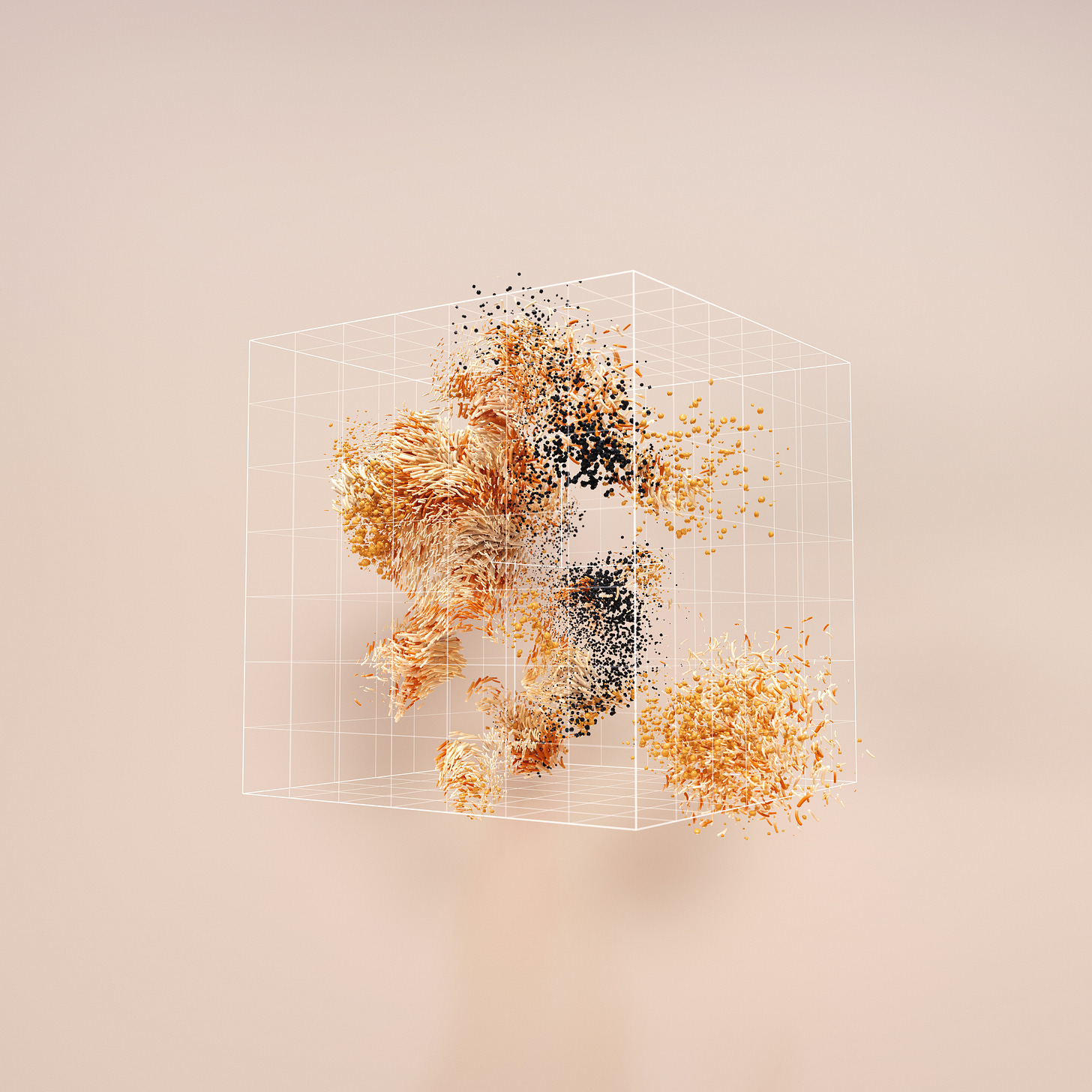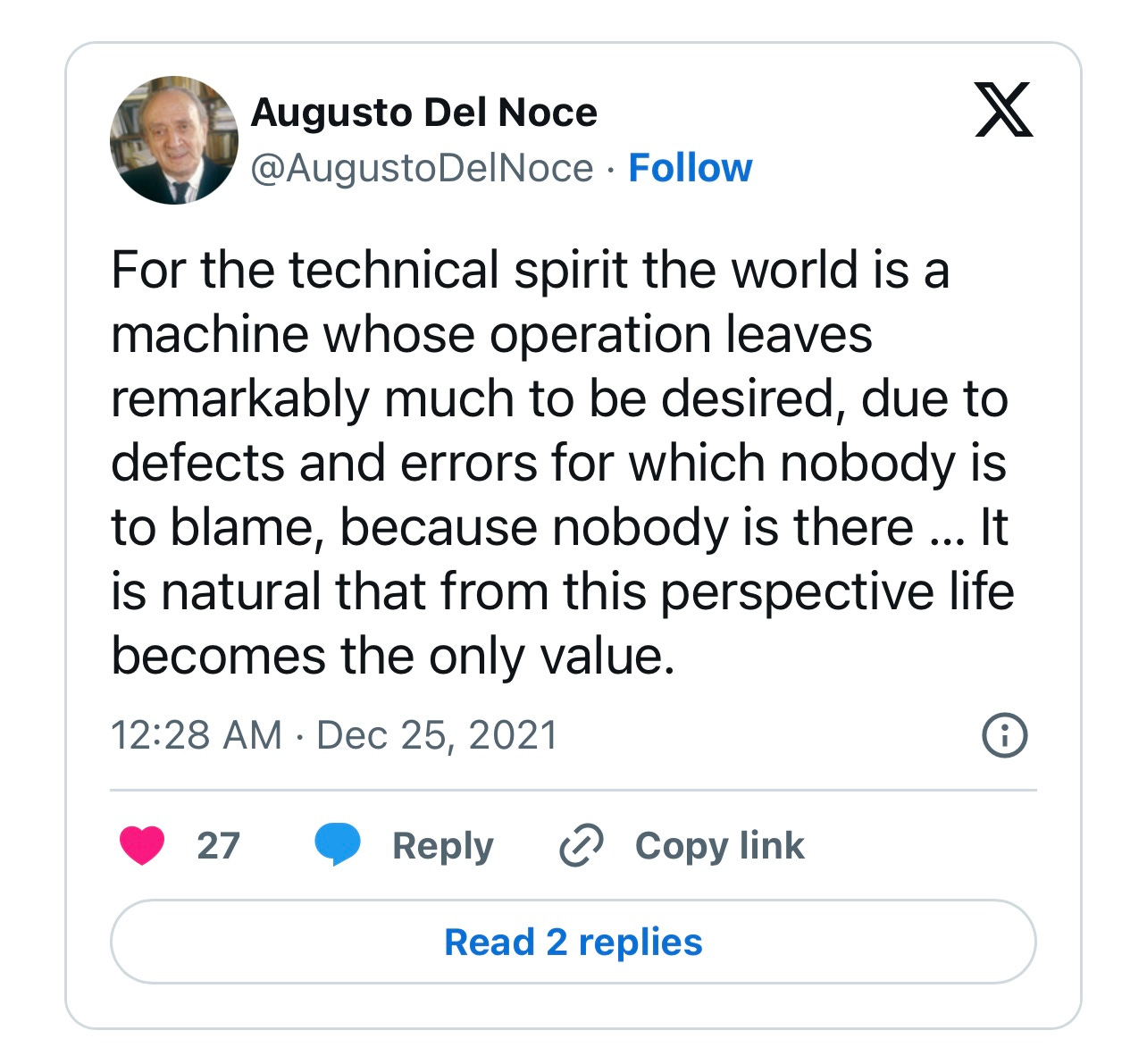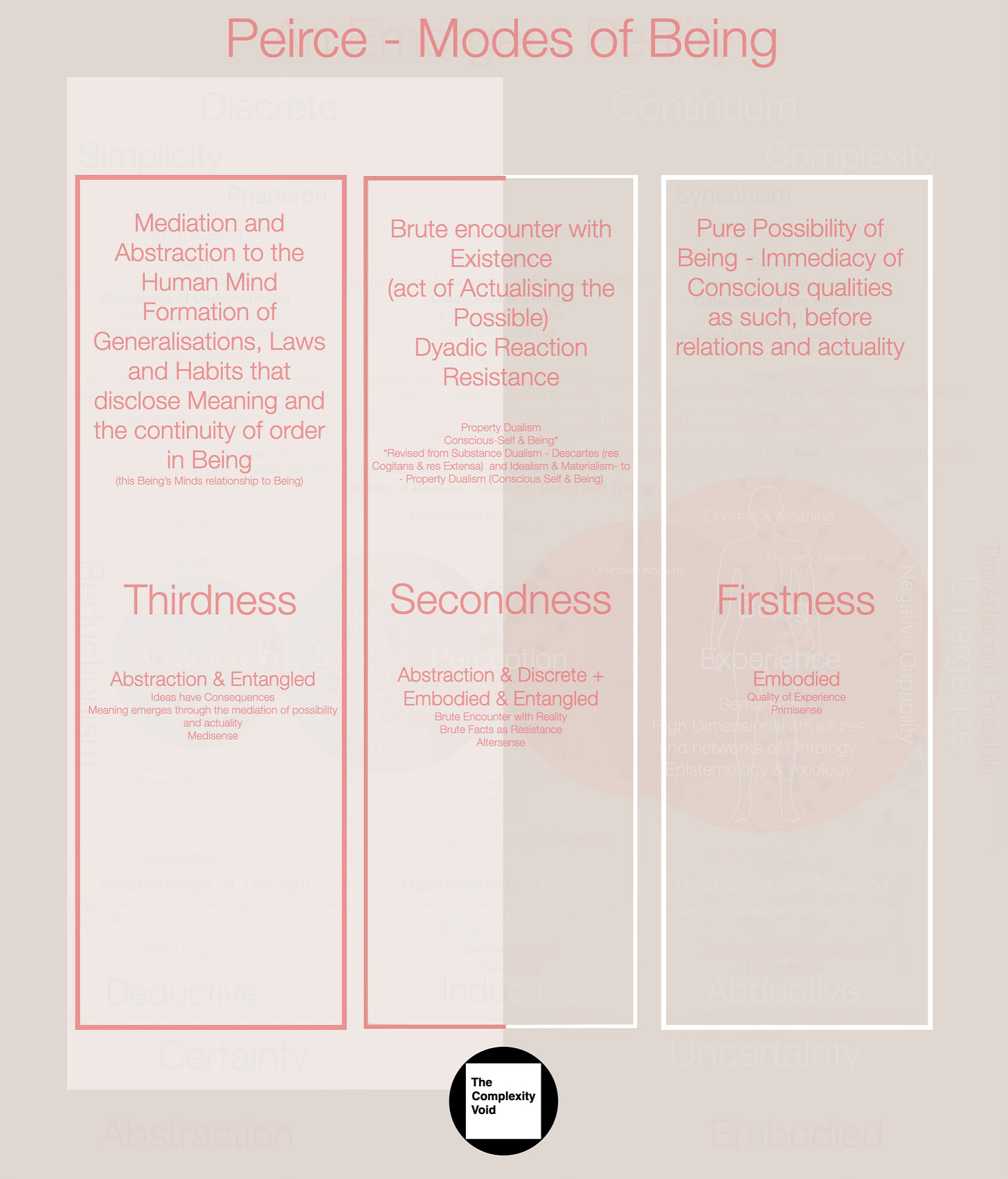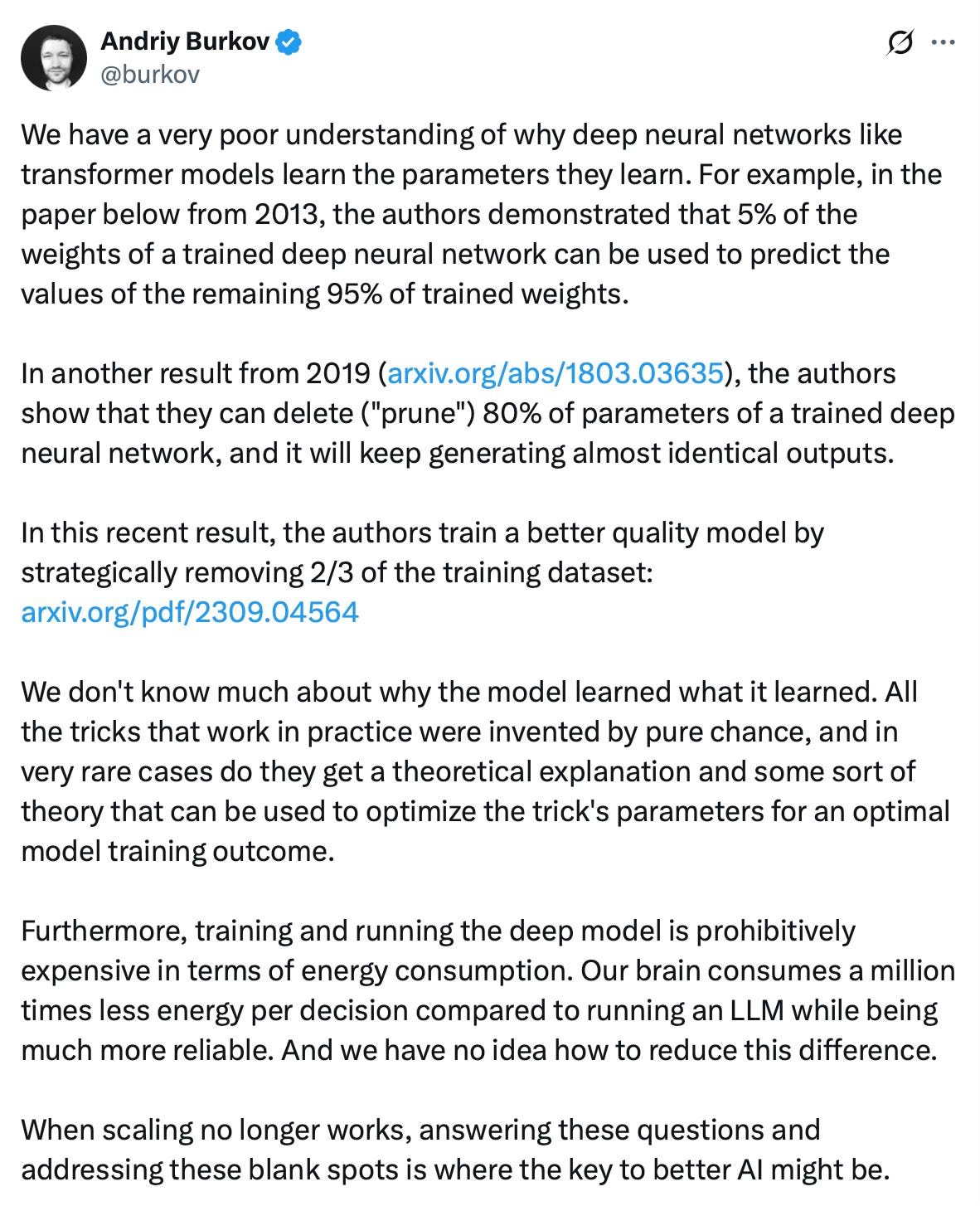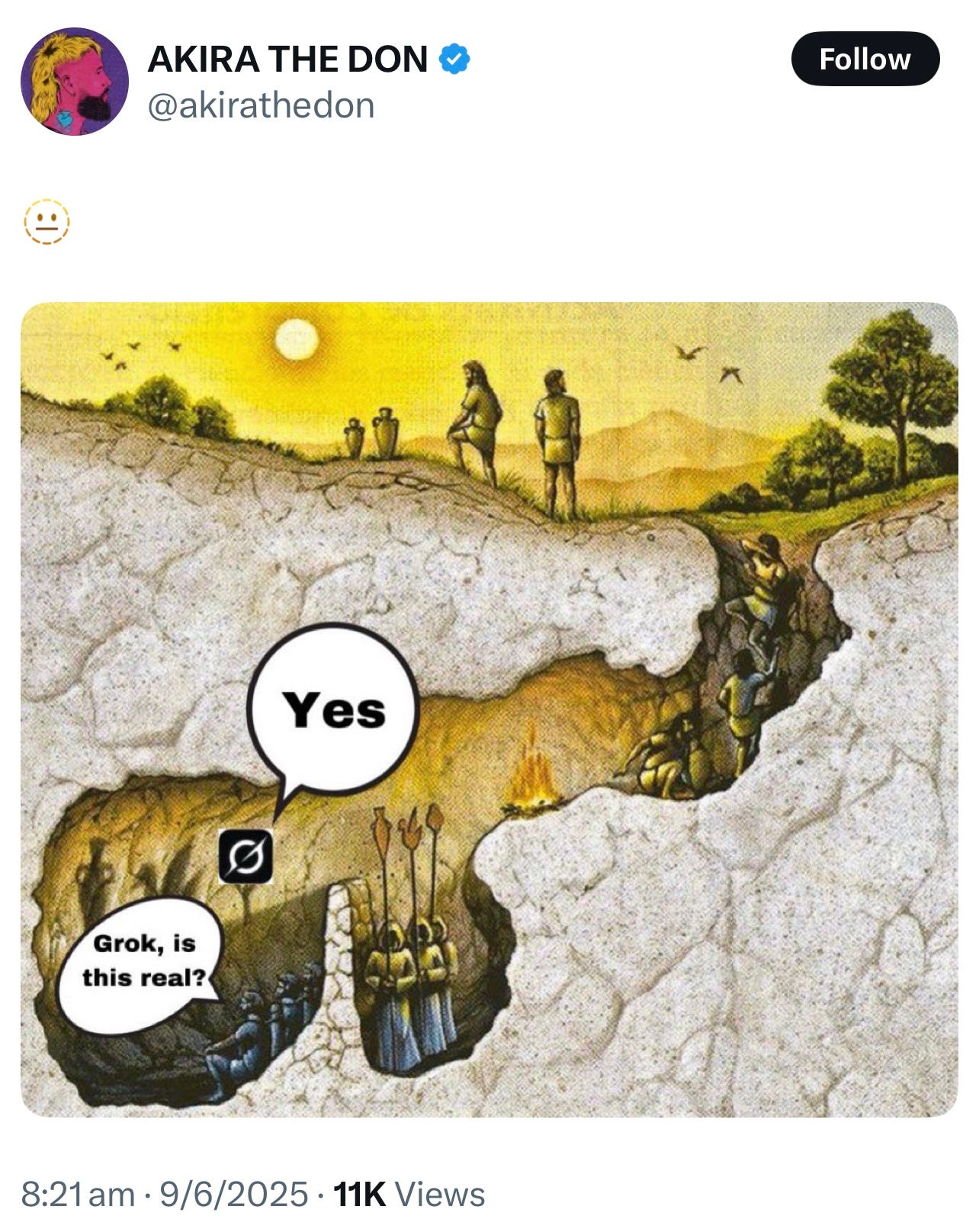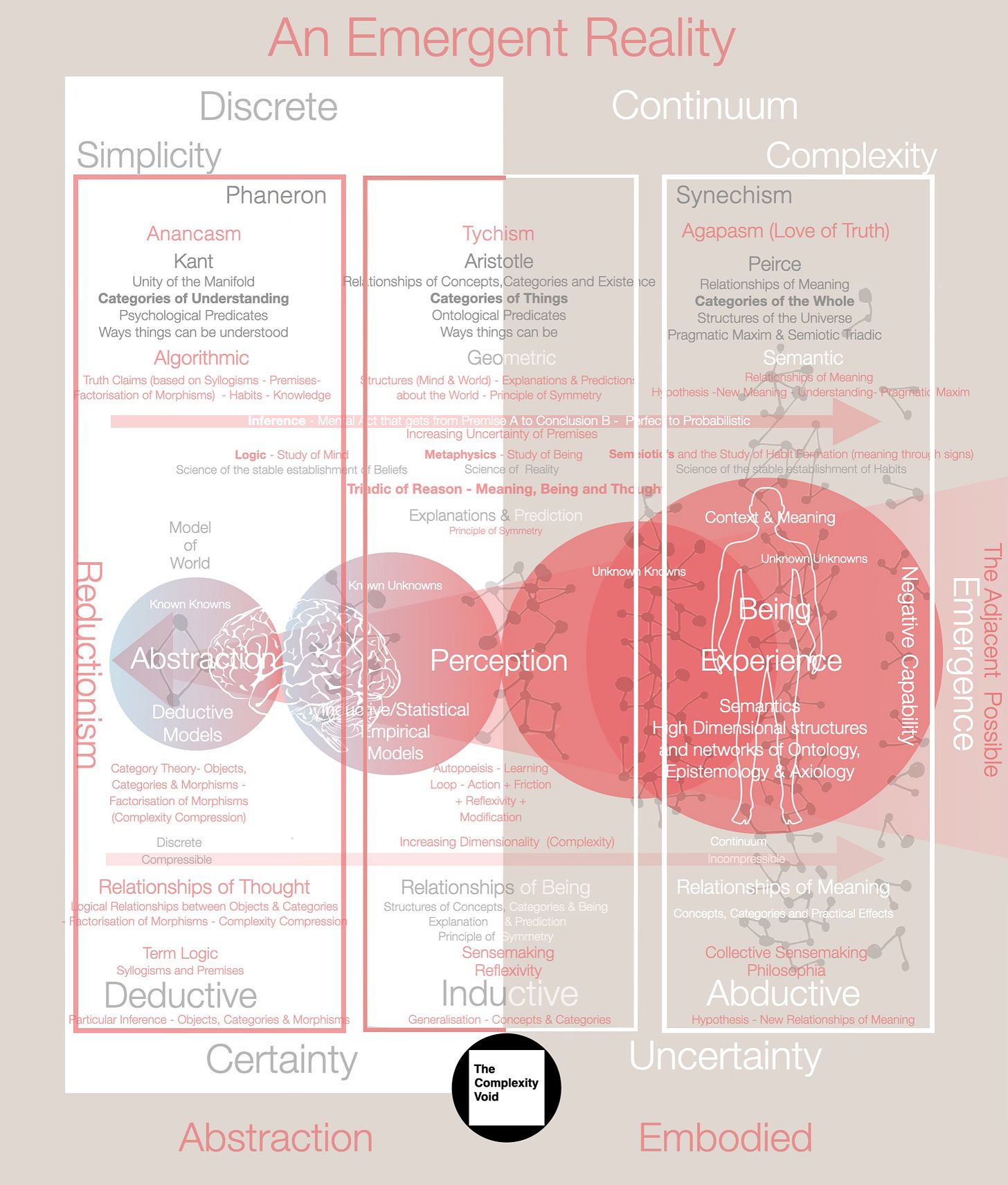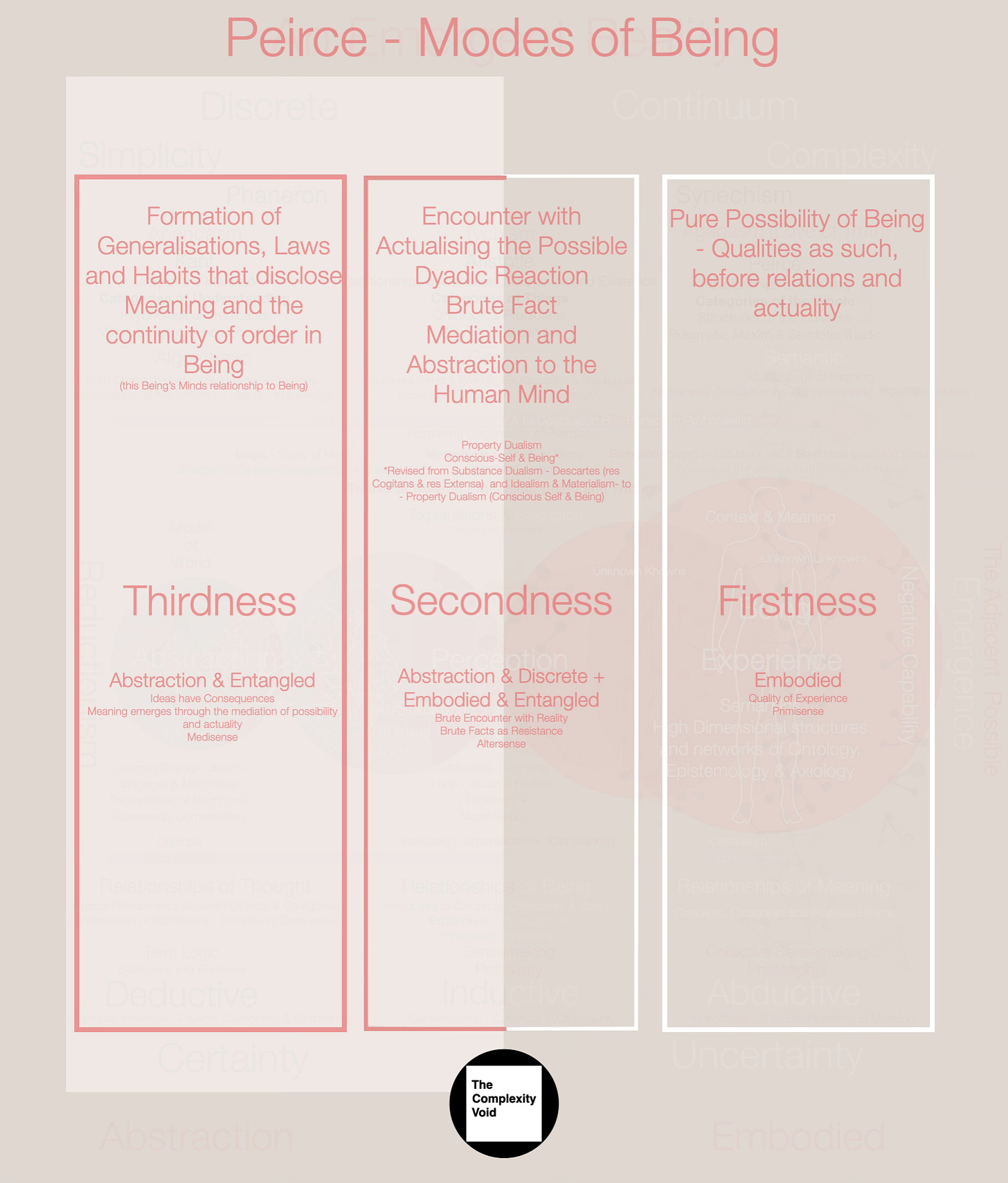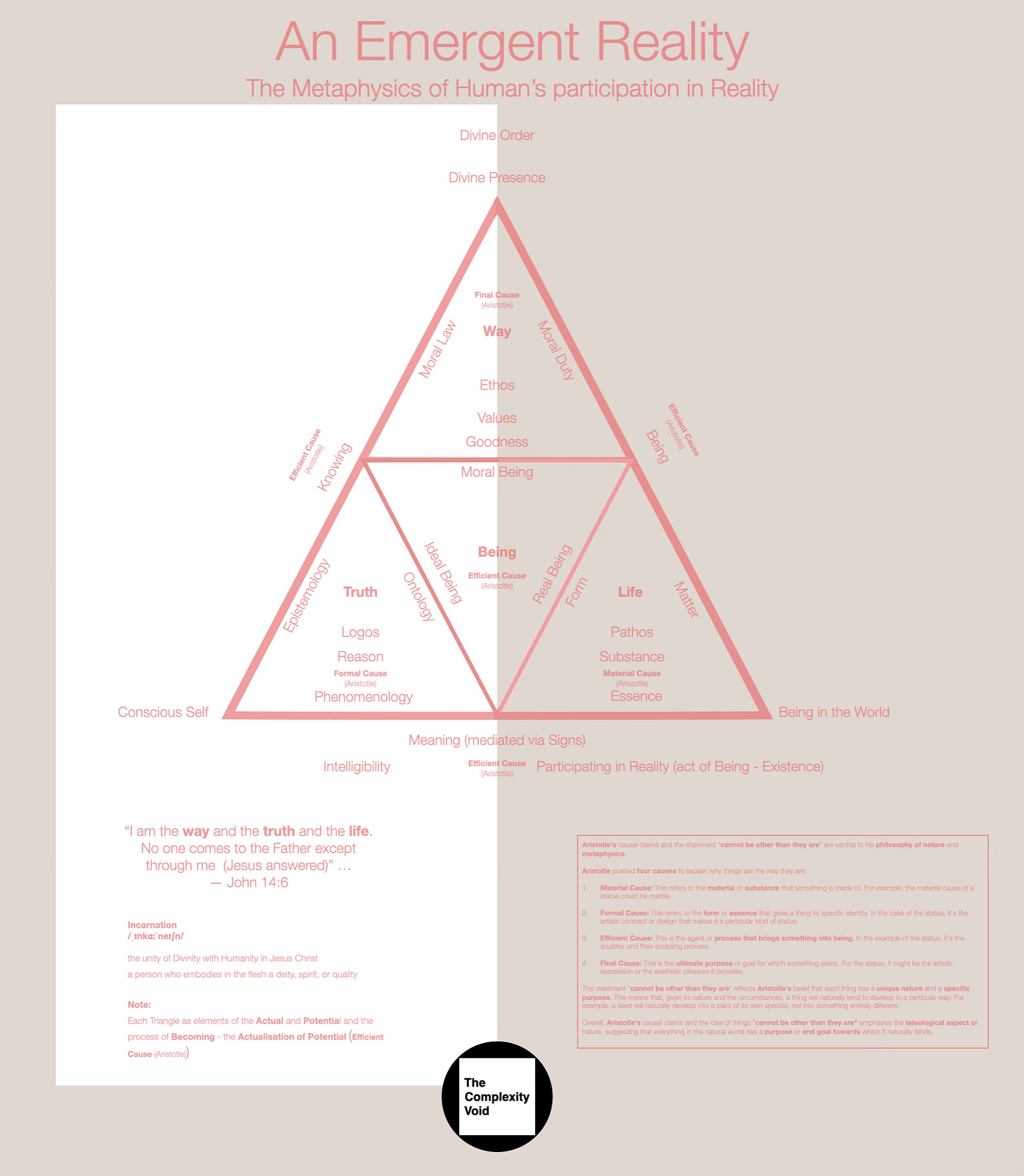Geometries of Unknowing
An Absence of Being
Photo by Google DeepMind on Unsplash
“The sad thing aboutartificial intelligenceis that itlacks artificeandtherefore intelligence”…
— Jean Baudrillard
“Acategory mistake, acategory error,categorical mistake, ormistake of a categoryis asemantic or ontological errorin which things belonging to a particular category are presented as if they belong to a different category or, alternatively, a property is ascribed to a thing that could not possibly have that property” …
The prevailing orthodox narratives relating to Artificial General Intelligence [LINK], Super Intelligence [LINK] and the Singularity [LINK] [LINK] reflect Extraordinary Popular Delusions and the Madness of Crowds [LINK].
A phenomenon that has occurred at various times throughout human history (Example A [LINK] - Example B [LINK] ) where Societies become increasingly detached and decoupled from Reality.
“In Individuals, insanity is rare; but in Groups, Parties, Nations and Epochs, it is the rule”…
— Friedrich Nietzsche
Entering the Theatre of the Absurd [LINK] [LINK].
Whole communities suddenly become deluded, fixed upon one object and go mad in its pursuit.
The Anthromorphism of Theology, Philosophy and Metaphysics and the attempted Liberation of Man
As outline in Schism [LINK] the origins of this gradual decoupling from Reality can be traced all the way back to the Middle-Ages when Theology (e.g. Protestant Reformation and subsequent 19th/20th Century emergence of Marxism), Philosophy (e.g. Cartesianism and 19th/20th Century Nietzschean Perspectivism, Idealism, Modern Gnosticism) and Metaphysics (e.g. Nominalism) were all beginning to be widely embraced and anthropomorphised [LINK].
[LINK]
A gradual metaphysical drift towards a Primacy of Human Consciousness [LINK] and Primacy of Man (e.g. Marxism [LINK]).
[LINK]
A Long March [LINK].
“We live in the complete eclipse of traditional ideals, an eclipse that can make one think it is a “sunset”.Since 1945 a new historical period has begun: that of homo progressivus. But is it a question of “rising ideals”, or of “the obscuration of intelligence”?”…
- Augusto del Noce
[LINK]
A Promethean Impulse [LINK] and Modernity’s Deconstruction of the Triadic of Being [LINK].
[LINK]
The Deconstruction of the Logos [LINK].
The Liberation of Man [LINK].
“There is a commonly held view that the arrival of Modernism represented the liberation of Man.A liberation from the transcendentincluding traditional moral values and religion (refer to Nietzsche).A liberation from the Human Conditionthat was inherent within the Contingent Being of Man (refer to Artificial General Intelligence, Trans Humanism, Scientific Gnosticism (Scientism), Nietzschean Übermensch, Nietzschean Will to Power).A liberation from the intolerable conditions and suffering of the Material Realm through attaining a Consciousness - a Gnosis(refer to Gnosticism including Modern Gnosticism, Trans Humanism, Geo-Bio-Genetic-Engineering, Cartesian Mechanical Machine World View, Heidegger’s Technology Enframing (Bestand - Standing Reserve), and Jacques Ellul’s Technology Society & System).A liberation from an independent objective Reality (refer to the Theology of Marxism(i.e. a power-directed system of thought), Nietzsche’s Theory of Perspectivism, Saussurean Dyadic Semiotics, Jean Baudrillard’s Post-Modern Simulacra, Simulation and HyperReality).The material manifestation of this idea is ever-present in various Revolutions that have occurred across the World post the arrival of Modernity including inter alia the French, Russian, and Chinese variants.Idealism & Materialism - Dialectical Materialism, Praxis, Reflexivity, Historical Materialism and a perpetual OODA Loop of man-made change and transformation. A City of Man (Civitas Hominis) without a City of God (Civitate Dei). Man as God”…
— The Complexity Void
The New Dark Age - The Perspectivism of Modernity & Post-Modernity and the Disintermediation of Reality through Semiotic Signs [ LINK ]
Descartes Mechanistic World View and the Mechanisation of the Human Mind
“We can look at different levels. One is actually to question authority. One would no longer look up what Aristotle said in order to find out how the world works. Let’s investigate it ourselves. The second is, obviously, the focus on observation. The third, I guess, is to put forward a hypothesis that were tested. Galileo was testing Hypotheses for much of his life, particularly in relation to mechanics. And the fourth was a suspicion that ultimately the World was a “kind of machine” or nature was a Machine. When Galileo said the “book of nature” was written in the language of mathematics, that’s very close to a mechanical idea of nature which was developed enormously by Descartes.As far as Descartes was concerned, all of nature was mechanism including animals and including our body’s, and we were “ghosts in these machines”. And of course, that climaxed in Newton, the whole idea of the Universe being a great huge clock of intermeshing parts”…— Raymond Tallis
[ LINK ]
The ideas of modern French philosopher Rene Descartes deeply shaped Modernity’s understanding of the nature of Reality [LINK].
“To think that we can strike out of our own minds a true preconception of how Nature acts, is a vain fancy”…
—Charles Sanders Peirce
Whilst 20th Century Philosopher Martin Heidegger saw Vorhandenheit as a secondary derivative mode of Being and literally, a decoupling from Reality, it was a Cartesian [LINK ] form of consciousness that had gradually become endemic as Modernity progressed [ LINK].
[LINK]
A Metaphysics inversion (reverse order) where Abstraction to the Mind took precedent over Human Being in the World and Existence.
“Both ignorance and the old metaphysics tend to produce these undesirable nervous effects of reversed orderand so non-survival evaluation.If we use the nervous system in a way which is against its survival structure, we must expect non-survival.Human history is short, but already we have astonishing records of extinction”…
— Alfred Korzybski
A Human Mental Structure version of Reality (a Primacy of Human Consciousness) anchored in more and more abstraction [LINK].
Not only was the World a Cartesian Mechanical Machine (refer to quote above), but this analogy was extended to our understanding of the Human Body [LINK] [LINK] and the Human Mind [LINK].
[LINK]
In his book On the Origins of Cognitive Science - The Mechanisation of the Mind [LINK] ,French 20th Century Philosopher Jean-Pierre Dupuy was highly critical of the intellectual direction and pathway that Cognitive Science had taken.
He believed that the early promise of Cognitive Science as providing an integrative understanding of the Human Mind had not been fulfilled, given the philosophical axioms embraced and the disregard of the discipline’s origins (e.g. First & Second Order Cybernetics).
Instead, intelligence was being attempted to be modelled through symbols (semiotic signs), formalism, algorithms, symbolic computation [LINK] and logic.
“Theabuse of symbolismis like the abuse of food or drink: itmakes people ill, and so their reactions become deranged”…
— Alfred Korzybski
He challenges the narrative of treating humans as programmable systems and machines by embracing formal models.
The simplistic notion that our mental life and behaviour could be reduced and simulated, without accounting for consciousness, agency, intentionality, or meaning.
[LINK]
[LINK]
Refer - AI’s Biggest Threat: Young People Who Can’t Think [LINK]
The Simulacra of Being: The Intellectual Orthodoxy’s Inevitable Progression from the Human Mind as a Mechanical Machine to the Narrative of Artificial General Intelligence
“The famous pipe. How people reproached me for it! And yet, could you stuff my pipe?No, it’s just a representation, is it not? So if I had written on my picture “This is a pipe”, I’d have been lying!
”…
— René Magritte
Given that the prevailing intellectual orthodoxy had embraced:
the Anthropomorphism of Theology, Philosophy and Metaphysics [LINK];
the Cartesian orientation towards a Primacy of Human Consciousness [LINK] and Logic (Study of Thought); and
a Cartesian Mechanical World View [LINK] that extended to the Mechanisation of Mind [LINK] and Body [LINK] [LINK];
it was inevitable that Computers (i.e. Mechanical Turing Machines [LINK]) would be viewed as Intelligence [LINK].
Refer - On Computable Numbers, with an application to the Entscheidungsproblem by A M Turing, November 1936 [LINK]
The Map had become the Territory [LINK].
“The map is not the territory... The only usefulness of a map depends on similarity of structure between the empirical world and the map”…
— Alfred Korzybski
A Simulacra of Being [LINK].
[LINK]
It was an inversion of the Ontological nature of Being [LINK].
It was an inversion that failed to recognise the Limits of Logic (Godel) [LINK].
Is Computation Intelligence?
“Logic and metaphysics make no special observations; but they rest upon observations which have been made by common men”…
– Charles Sanders Peirce
In the Obfuscation of Intelligence - Modernity, Post-Modernity and the Tower of Babel [LINK] and The Ghost in the Machine- Intelligence is not Computation [LINK] the very notion of Computation being Intelligence [LINK] was debunked.
[LINK]
[LINK]
The idea was an ontological philosophical error, a category mistake, a category error, a categorical mistake, a mistake of a category, a semantic error in which things belonging to a particular category are presented as if they belong to a different category or, alternatively, a property is ascribed to a thing that could not possibly have that property.
It was a mental structure perspective of Reality anchored in the Primacy of Human Consciousness and Logic (i.e. Study of Thought) that was increasingly leading to a view of Reality anchored in more and more rules of abstraction - World as a Machine, Mind as a Computer, Cells as Machines, Body as a Machine, Intelligence as Computation, Geo-Engineering, Bio-Engineering, Genetic Engineering, Algorithmic Management, Technology Society, Technology System, Artificial General Intelligence, Algorithmic Governance, Algorithmic Money etc.
“So we must start from thisdual natureofintelligenceas something bothbiologicalandlogical”…
― Jean Piaget
It was also a view that failed to recognise the Dualism of Consciousness [LINK] and the fundamental difference between:
Vorhandenheit (Present-at-Hand - Secondary (Derivative)) and Zuhandenheit (Being-Ready-to-Hand - Primary) [LINK]
or stated differently
Abstraction to the Mind [LINK] and this Being’s (Dasein) relationship to Being (Sein) (Heidegger) [LINK] - Being in the World [LINK].
or stated differently
Noting that without Being there simply is no Existence [LINK].
[LINK]
A failure to recognise the Semiotic Triadic nature of intelligibility in humans’ participation in Reality [LINK].
[LINK]
A failure to recognise the role of Charles Sanders Peirce’s (America’s Aristotle) [LINK ] three modes of Being in Human Intelligence.
[LINK]
Noting that without Firstness there simply would be nothing [LINK] [LINK] - Being as the Teological Common Ground of Divine and Natural Revelation [LINK].
“To be a nominalist consists in the undeveloped state of one’s mind of the apprehension of Thirdness as Thirdness****. The remedy for it consists in allowing ideas of human life to play a greater part in one’s philosophy.Metaphysics is the science of Reality”…
– Charles Sanders Peirce
****Note - To apprehend Thirdness as Thirdness means to grasp the reality of the whole, the mediating structures that connect signs, minds, and the world. It is the capacity to recognise that meaning, being and knowing are inherently connected. [LINK] Habits, laws, actions and ideas are real and interdependent. Peirce viewed a nominalist as someone whose philosophical mind was insufficiently developed to recognise the actuality of generality of abstraction. Thirdness can be interpreted as the mediation of both an epistemological and ontological mode of Being ( i.e. one of three modes of Being - Firstness, Secondness and Thirdness - Peirce’s Phenomenological Categories that form a Triadic alongside Aristotle’s Ontological Categories and Kant’s Epistemological Categories).
[LINK]
Computers as Semiotic Sign Machines and the Geometric Structures of Human Abstraction
“The reason that no computer program can ever be a mind is simply that a computer program is only syntactical, and minds are more than syntactical. Minds are semantical, in the sense that they have more than a formal structure, they have a content”…
– John Searle
Rather than viewing the Human Mind as a Mechanical Machine [LINK] and hence a Computer (a Turing Machine) as Artificial General Intelligence, what if a Computer was a Semiotic Sign Machine [LINK]?
Refer - Computer Semiotics [LINK]
[LINK]
What if the abstraction of Human thought, where meaning is mediated via Semiotic Signs (refer Charles Sanders Peirce), was high-dimensional and spatial [LINK]?
[LINK]
Where Human’s capacity to derive meaning from our embodied lived experiences in the World (Being in the World) is facilitated through the entanglement of Meaning (mediated via Semiotic Signs) in lower-dimensional relational structures (a manifold)?
An entanglement of semiotic signs (Peirce) where meaning (Peirce) is brought from our participation in Reality [LINK] to separation and abstraction to the Mind through Inductive Reasoning [LINK].
[LINK]
An ability to leverage the blessing of dimensionality [LINK] and, via inductive reasoning, generalise from particulars [LINK]
[LINK]
What if our innate capacity to understand (via our Human Mind) our participation in Reality can be further refined through deductive reasoning and logic [LINK].
[LINK]
Reductionism techniques such as the factorisation of morphisms (category theory) [LINK] and revealing geometric symmetries (Felix Klein) [LINK] - Anderson (Physics - Symmetry) [LINK] - in the structures and relationships of semiotic signs [LINK]?
Geometries of Unknowing - Absence of Being
“According to Guenon,the crisis of the Modern World is first of all metaphysical. The negation of authority isnot a stage or a consequence of Rationalism; it is rather its precondition, asrejection of a super-human order and of a cognitive faculty higher than individual reason”…
— Augusto del Noce
Given that both low-dimensional (top-down deductive deterministic) Classical Computing and more recently, high-dimensional (bottom-up inductive probabilistic) Computing techniques such as Deep & Machine Learning, are both anchored in Logic via Rules of Abstraction (Syntax) and the manipulation & transformation of Semiotic Signs (i.e. information/data) [LINK], then how can these systems be Intelligent?
“To be a nominalist consists in the undeveloped state of one’s mindof the apprehension of Thirdness as Thirdness.The remedy for it consists in allowing ideas of human life to play a greater part in one’s philosophy. Metaphysics is the science of Reality”…
— Charles Sanders Peirce
Without Being [LINK] and Firstness [LINK], what is the light of illumination [LINK]?
[LINK]
How will the Computer make the transition from Being to Knowing [LINK] or is Machine Learning and Deep Learning simply illustrating the Geometries [LINK] of Unknowing?
Refer - 27 April 2021 — Academic paper and proto-book titled Geometric Deep Learning: Grids, Groups, Graphs, Geodiscs and Gauges.
High-dimensional relationships and structures of semiotic signs [LINK] without a Semiotic Triadic (Peirce) that includes an Observer or an Observed (Peirce - Semiotic Triadic and Pragmatic Maxim).
[ LINK ]
A World of more & more abstraction and an increasing absence of this Being’s (Dasein) relationship to Being ( Sein) (Heidegger ).
A retreat back into Plato’s Cave. [LINK]
[LINK]
Hence, the Scholastic Foundations of a Classical Revival are more important than ever [LINK].
[LINK]
Particularly, as we progress through an Age of Meaning [LINK].


